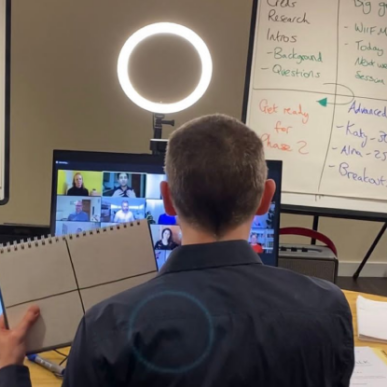“Stories that are personal and emotionally compelling engage more of the brain, and are better remembered, than simply stating a set of facts.“
How To Use Storytelling in Business to Motivate Your Team
Leaders have been using stories to communicate since the dawn of time. It’s how we’ve evolved as humans by using stories to pass on important information. As early cave dwellers, we’d have told the tale of dangerous animals lurking in the nearby forest to warn others, cities and empires were built on stories, and today, instead of storytelling around the campfire, modern leaders are using it in the workplace to motivate and inspire their teams.
But in today’s fast-paced work environment, managers and leaders often default to more direct forms of communication, like emails, memos, or bullet points in a presentation. While there’s a time and place for these methods, don’t let these be your only options. Storytelling should also be part of your toolkit because it’s an incredibly powerful way to connect with your team, explain complex concepts, and rally people around a common goal.
Why is storytelling in business important?
The best stories can transport us to another time and place, make us laugh, cry, or think deeply about the world around us. They can also motivate us to take action. Many of the world’s most successful companies, like Apple and Nike, have built their brands on storytelling. And some of history’s most influential leaders, like Martin Luther King Jr. and Mahatma Gandhi, have used storytelling to change the world.
There’s science behind storytelling too. Neuroscientist Professor Paul Zak says, ‘Stories that are personal and emotionally compelling engage more of the brain, and thus are better remembered, than simply stating a set of facts.’
Jennifer Aaker, Professor, Stanford Graduate School of Business, says our brains are wired to remember the information told in a story, with studies suggesting stories are 22 times more memorable than facts or figures alone. Imagine the impact of that increased memorability on your team or organisation.
So, if you want to be a more effective leader, try using storytelling in the workplace. Here are three ways storytelling can help you motivate and inspire your team:
Stories Help Us Connect Emotionally
When we hear a story, we remember the facts and the characters’ emotions; this emotional connection allows stories to stay with us long after we’ve heard them and can help managers and leaders to connect and engage their teams.
Let’s be clear, an emotional message is generally not about making your audience happy or sad. The purpose is to make them care. When people feel something or when they care about something, it inspires them to take action. In order for people to care, the message has to be relatable on an emotional level. A classic storytelling tool to make people care is describing a challenge or pain point from the audience’s perspective. This works because, on a simple, human level, we want to avoid pain and gain pleasure. Talking about something missing or broken in your audience’s world can motivate them to come on the journey with you towards a better future.
Stories Help Us Make Sense of the World
We’ve all been in a situation where we’re trying to explain something complicated to someone, and no matter how many different ways we try to say it, they just don’t seem to get it. Stories can help us make sense of the world by providing context and helping us see things from another person’s perspective.
When you’re trying to explain a complex idea, tell a story that illustrates the concept. This will help your team understand what you’re trying to say and why it’s important. And when they understand the context and the reasoning behind your message, they’ll be more likely to buy into it. Author Stephen R Covey uses this example:
“He once tried to give the dry statistics: Only 37% of employees had a clear idea of their mission, only one in five was enthused etc. He got more impact when he mapped this onto a soccer team: “If a soccer team had this same makeup, only 4 out of 11 would know where their goal was.”
Stories Help Us Remember
We all know the power of storytelling from our childhood. How many of us remember the stories our parents or grandparents told us but can’t remember the dry facts from our history books? I recently watched ‘Hamilton’ – the musical based on the life of America’s founding father, Alexander Hamilton, and I now feel like an expert in America’s early history! Names, dates, and locations are now lodged in my memory because they were part of an emotional, engaging story.
In their book, Made To Stick, Chip and Dan Heath talk about six areas which can make ideas stick and help your audience remember.
- Simple: Simplicity is achieved when an idea is stripped down to its core, to the most essential elements that make it work. The goal is to simplify an idea without making it trite. The difficult task is determining which aspects are important yet not vital – distilling it down to the most crucial concept or core message.
- Unexpected: Something which disrupts our attention or goes against the grain becomes more memorable. When we hear or see these kinds of messages, they grab our attention, and we don’t let go until we satisfy our curiosity by learning more about them or understanding how they work.
- Credible: for people to be engaged, they need to trust you, and for them to trust you, they’ll need to believe you’re credible. Personal credibility is important in business storytelling and is often missed or avoided because we don’t like talking about ourselves or presume people know who we are. Bring in a mix of logical and emotional credibility to connect with your audience. By that, I mean it’s not just your name, job title and experience but what you have in common with the audience.
- Concrete: Something becomes concrete when it can be described or detected by the human senses. Since we all process information differently, it’s important to share our ideas in a way everyone can understand. That means using concrete language and examples instead of abstract concepts.
- Emotions: As mentioned earlier, your audience is more likely to care about your idea if it’s relevant to them on a personal level. We are all subconsciously drawn to things that reflect our wishes, desires, and hopes back at us. Also, we feel more strongly for people than we do for abstract concepts.
- Stories: This brings us full circle to the point of the blog. Stories help us imagine different worlds, people, and emotions beyond our own experience. Remember that people connect with other people, not faceless corporations. Storytelling in business is a powerful way to forge those connections.
So tell a story next time you’re trying to motivate your team or explain something complicated. It just might help your team understand what you’re trying to say.
Can We Help You With Your Business Storytelling?
Still need some help? We offer many options to help you or your team improve your business storytelling skills. From our science of storytelling training or 121 coaching, we have something to fit all time frames and budgets. Get in touch today to discuss how we can help you achieve your communication goals.
You can also watch or listen to our podcast below, where Richard speaks to award-winning journalist Cristina Mendonsa about powerful storytelling and its ability to move people and businesses forward.
Powerful Storytelling: How To Tell A Great Business Story from Body Talk on Vimeo.





















